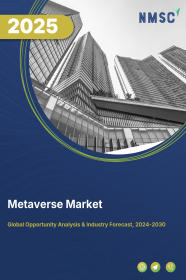
Metaverse Market by Type (Traditional Centralized Metaverse, Centralized Blockchain Metaverse, and Decentralized Blockchain Metaverse), by Component (Hardware, Software, and Services), by Platform (Microsoft Windows, Google Android, Apple iOS and MacOS, and Others), by Application (Gaming, Online Shopping, Content Creation and Social Media, Events and Conference, Digital Marketing, Testing and Inspection, and Others) and Others- Global Opportunity Analysis and Industry Forecast, 2023 – 2030
Market Definition
The global Metaverse Market size was valued at USD 55.40 billion in 2022 and is predicted to reach USD 988.54 billion by 2030 with a CAGR of 44.1% from 2023-2030. Metaverse can be defined as a digital space in which multiple users can interact with each other in a computer-generated environment. It combines the aspects of social media, online gaming, augmented reality (AR), virtual reality (VR), and blockchain technology to create a shared and realistic computer simulation of the real-world.
Metaverse enables a user to create their avatars for interactions and other experiences such as entertainment, shopping and leaning in a digital environment, which is able to provide realistic involvements from anywhere in the world.
Market Dynamics and Trends
Increasing adoption of augmented reality (AR) and virtual reality (VR) technologies in entertainment and gaming industry as it can offer first-person perspective to create realistic-looking virtual scenarios and enhance overall experience of an end user is driving the metaverse market growth. Also, rapidly increasing adoption of metaverse by various global brands such as Nike, Adidas and Samsung to showcase and retail their products virtually by providing an enhanced customer experience is further driving the growth of the market. For instance, in January 2022, Samsung launched a virtual showroom called Samsung 837X in the metaverse of decentraland. It is a virtual replica of Samsung’s flagship store 837 in New York City.
However, cybersecurity and privacy issues associated with metaverse and health concerns regarding the extended use of VR headsets and other devices to stay connected to the virtual worlds of metaverse are the factors restraining the growth of the market. On the contrary, use of metaverse in military and defence sector for several training programs such as VR flight simulator training and combat training is expected to create ample growth opportunities for the market in the coming years.
Market Segmentations and Scope of the Study
The metaverse market report is segmented on the basis of type, component, platform, application, end user industry and geography. Based on type, the market is divided into traditional centralized metaverse, centralized blockchain metaverse, and decentralized blockchain metaverse.
Based on component, the market is classified into hardware, software, and services. The hardware segment is further segmented into AR devices, VR devices, MR devices, and displays. The software segment is further segmented into extended reality software, gaming engines, 3d mapping modeling and reconstruction, financial platforms, and others.
Based on platform, the market is divided into microsoft windows, google android, apple iOS and MacOS, and others. Based on application, the market is categorized into gaming, online shopping, content creation and social media, events and conference, digital marketing, testing and inspection, and others.
Based on end user industry, the market is classified into (BFSI, retail, media and entertainment, education, aerospace and defence, automotive, travel and tourism, real estate, healthcare, and others.
Geographic breakdown and analysis of each of the previously mentioned segments include regions comprising North America, Europe, Asia-Pacific, and RoW.
Geographical Analysis
North America holds the major share of metaverse market and is expected to continue its dominance during the forecast period. This is attributed to factors such as adoption of metaverse for military purposes in this region to train soldiers using flight simulation, battlefield simulation, medic training and vehicle simulation. Military training in virtual environments using custom-built AR and VR wearables can provide realistic battlefield experience that further improves military training. For instance, in May 2022, US military announced that it is building its own military metaverse to reduce costs associated with training and provide shoulders with immersive training programs in virtual environments.
Moreover, presence of key market players such as Meta, Nvidia, Epic Games, Roblox and Microsoft further boost the market growth in this region. For instance, in March 2022, Microsoft launched a limited preview version of its mixed reality (MR) platform called Mesh. Microsoft aims to roll out the full version of Mesh by end of 2022, which will feature Microsoft Holoportation technology that allows a user to project a lifelike, photorealistic self in mixed reality to interact with other users.
However, Asia Pacific is expected to show a steady rise in the metaverse market owing to the increasing adoption of metaverse in banking sector in this region to enhance customer experience by providing virtual access to bank facilities. For instance, in November 2021, South Korea’s Kookmin bank launched KB Metaverse that allows customers to access banking services and one-on-one consultations between customer and employee avatars in the metaverse using head-mounted VR device.
Moreover, several initiatives taken by the government in this region to increase awareness and adoption of metaverse further boost the market growth. For instance, in May 2022, Government of South Korea announced that it is building a metaverse platform in Seoul to allow citizens to access public services virtually. In addition, South Korea aims to invest around 177 million USD in future metaverse projects.
Competitive Landscape
Various market players operating in the metaverse industry include Decentraland Foundation, Meta Platforms Inc, NVIDIA, Epic Games, Roblox Corporation, Microsoft Corporation, The Sandbox, Sky Mavis (Axie-Infinity), Tencent and Unity. These market players are adopting various joint venture strategies to maintain their dominance in the global market.
For instance, in April 2022, Epic Games and LEGO Group announced a partnership to build an immersive digital experience in the metaverse for kids to play and increase creativity.
Moreover, in November 2021, Roblox Corporation announced a partnership with Nike. Under this partnership Nike will launch its virtual world called Nikeland on Roblox’s online gaming platform enabling users to enter a digital showroom to explore latest product offerings by Nike.
Key Benefits
-
The metaverse market report provides the quantitative analysis of the current market and estimations through 2023-2030 that assists in identifying the prevailing market opportunities to capitalize on.
-
The study comprises a deep dive analysis of the metaverse market trend including the current and future trends for depicting the prevalent investment pockets in the market.
-
The information related to key drivers, restraints and opportunities and their impact on the global market is provided in the report.
-
The competitive analysis of the market players along with their market share in the market.
-
The SWOT analysis and Porters Five Forces model is elaborated in the study.
-
Value chain analysis in the market study provides a clear picture of the stakeholders’ roles.
Metaverse Market Key Segments
By Type
-
Traditional Centralized Metaverse
-
Centralized Blockchain Metaverse
-
Decentralized Blockchain Metaverse
By Component
-
Hardware
-
AR Devices
-
VR Devices
-
MR Devices
-
Displays
-
-
Software
-
Extended Reality Software
-
Gaming Engines
-
3D Mapping, Modeling, and Reconstruction
-
Financial Platforms
-
Others
-
-
Services
By Platform
-
Microsoft Windows
-
Google Android
-
Apple iOS and MacOS
-
Others
By Application
-
Gaming
-
Online Shopping
-
Content Creation and social media
-
Events and Conference
-
Digital Marketing
-
Testing and Inspection
-
Others
By End User Industry
-
BFSI
-
Retail
-
Media and Entertainment
-
Education
-
Aerospace and Defence
-
Automotive
-
Travel and Tourism
-
Real Estate
-
Healthcare
-
Others
By Geography
-
North America
-
U.S.
-
Canada
-
Mexico
-
-
Europe
-
U.K.
-
Germany
-
France
-
Italy
-
Spain
-
Denmark
-
Netherlands
-
Finland
-
Sweden
-
Norway
-
Russia
-
Rest of Europe
-
-
Asia-Pacific
-
China
-
Japan
-
India
-
South Korea
-
Australia
-
Indonesia
-
Singapore
-
Taiwan
-
Thailand
-
Rest of Asia-Pacific
-
-
RoW
-
Latin America
-
Middle East
-
Africa
-
Key Players:
-
Decentraland Foundation
-
Meta Platforms Inc.
-
NVIDIA
-
Epic Games
-
Roblox Corporation
-
Microsoft Corporation
-
The Sandbox
-
Sky Mavis (Axie Infinity)
-
Tencent
-
Unity

















 Speak to Our Analyst
Speak to Our Analyst




















